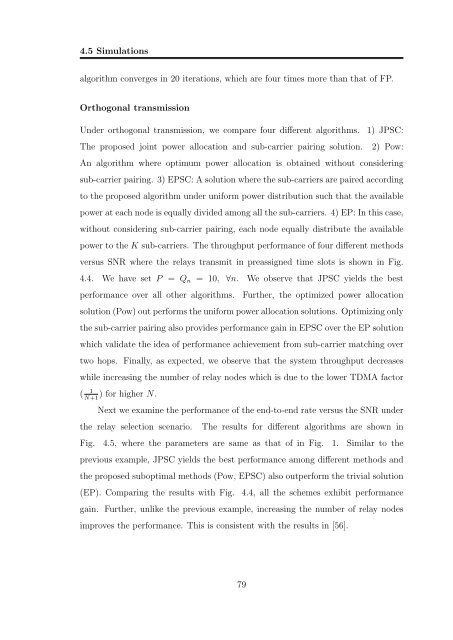Resource Allocation in OFDM Based Wireless Relay Networks ...
Resource Allocation in OFDM Based Wireless Relay Networks ...
Resource Allocation in OFDM Based Wireless Relay Networks ...
You also want an ePaper? Increase the reach of your titles
YUMPU automatically turns print PDFs into web optimized ePapers that Google loves.
4.5 Simulations<br />
algorithm converges <strong>in</strong> 20 iterations, which are four times more than that of FP.<br />
Orthogonal transmission<br />
Under orthogonal transmission, we compare four different algorithms.<br />
The proposed jo<strong>in</strong>t power allocation and sub-carrier pair<strong>in</strong>g solution.<br />
1) JPSC:<br />
2) Pow:<br />
An algorithm where optimum power allocation is obta<strong>in</strong>ed without consider<strong>in</strong>g<br />
sub-carrier pair<strong>in</strong>g. 3) EPSC: A solution where the sub-carriers are paired accord<strong>in</strong>g<br />
to the proposed algorithm under uniform power distribution such that the available<br />
power at each node is equally divided among all the sub-carriers. 4) EP: In this case,<br />
without consider<strong>in</strong>g sub-carrier pair<strong>in</strong>g, each node equally distribute the available<br />
power to the K sub-carriers. The throughput performance of four different methods<br />
versus SNR where the relays transmit <strong>in</strong> preassigned time slots is shown <strong>in</strong> Fig.<br />
4.4. We have set P = Q n = 10, ∀n. We observe that JPSC yields the best<br />
performance over all other algorithms.<br />
Further, the optimized power allocation<br />
solution (Pow) out performs the uniform power allocation solutions. Optimiz<strong>in</strong>g only<br />
the sub-carrier pair<strong>in</strong>g also provides performance ga<strong>in</strong> <strong>in</strong> EPSC over the EP solution<br />
which validate the idea of performance achievement from sub-carrier match<strong>in</strong>g over<br />
two hops. F<strong>in</strong>ally, as expected, we observe that the system throughput decreases<br />
while <strong>in</strong>creas<strong>in</strong>g the number of relay nodes which is due to the lower TDMA factor<br />
( 1 ) for higher N.<br />
N+1<br />
Next we exam<strong>in</strong>e the performance of the end-to-end rate versus the SNR under<br />
the relay selection scenario.<br />
The results for different algorithms are shown <strong>in</strong><br />
Fig. 4.5, where the parameters are same as that of <strong>in</strong> Fig. 1. Similar to the<br />
previous example, JPSC yields the best performance among different methods and<br />
the proposed suboptimal methods (Pow, EPSC) also outperform the trivial solution<br />
(EP). Compar<strong>in</strong>g the results with Fig.<br />
4.4, all the schemes exhibit performance<br />
ga<strong>in</strong>. Further, unlike the previous example, <strong>in</strong>creas<strong>in</strong>g the number of relay nodes<br />
improves the performance. This is consistent with the results <strong>in</strong> [56].<br />
79

















